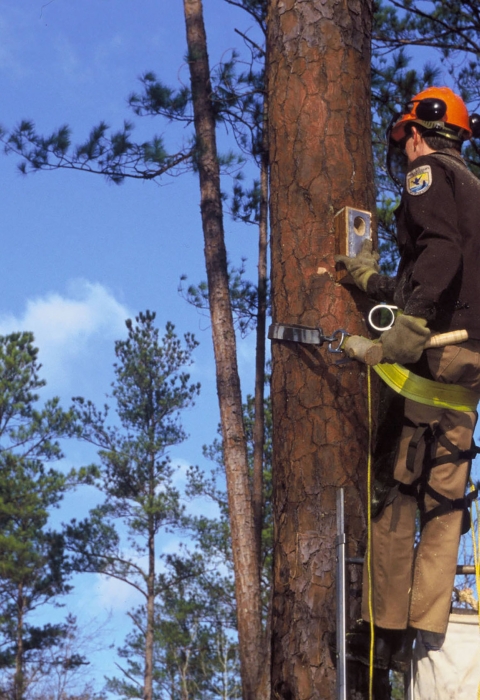Washington, D.C. – Today, the U.S. Fish and Wildlife Service and its partners celebrate the 20th anniversary of the first ever Safe Harbor Agreement (SHA), created in 1995 to protect the endangered red-cockaded woodpecker. That first SHA not only helped turn around the fortunes of the red-cockaded woodpecker in North Carolina and other states, but also heralded in an era of proactive collaboration between private landowners, states and federal agencies under the Endangered Species Act (ESA) to conserve America’s most imperiled wildlife.
Today more than 600 landowners are enrolled in SHAs across the country covering some 5.2 million acres of lands in 26 states and protecting nearly 100 species listed as threatened or endangered under the ESA. Through these agreements, landowners and wildlife agencies are maintaining and improving habitat for listed species, recreating lost habitat, and facilitating the reintroduction of species that had been lost in the wild, such as the black-footed ferret and the n?n? goose, Hawaii’s state bird.
In the case of the red-cockaded woodpecker more than 40 percent of the bird’s known populations are benefiting from 11 SHAs on 2.5 million acres of private lands, from southeastern Virginia to East Texas. Due to these and related efforts, populations of red-cockaded woodpeckers have transitioned from steep declines to a 25 percent increase in the number of family groups since the SHA program began in 1995.
“Safe Harbor Agreements are a powerful example of how the Service is working creatively and hand-in-hand with landowners to ensure America’s most at-risk wildlife and their habitats are around for future generations to enjoy,” said Service Director Dan Ashe. “Together, we have created a working conservation formula that is not only creating unprecedented landowner engagement in wildlife conservation, but is turning healthy lands and wildlife into assets for landowners.”
“As a fourth generation landowner, it is a great comfort to know that our ability to enjoy living on our land will not be inhibited by new restrictions due to the growth of red-cockaded woodpecker populations on our lands,” said Julian Johnson, a farmer in Raeford, North Carolina. “As a result of getting to know Fish and Wildlife Service personnel, we established a trust and our Safe Harbor Agreement was a natural progression of that trust. This has benefitted us and the woodpecker.”
In South Carolina, more than 160 landowners are enrolled in the state's red-cockaded Woodpecker Safe Harbor Program. Started in 1998, the program is administered by the South Carolina Department of Natural Resources, which coordinates with the Service and foresters in working with landowners to manage woodpecker habitat. Private hunting plantation owners have been principal stakeholders in the program, creating and protecting more than 330,000 acres of open pine forests, the bird’s primary habitat.
"It is very rewarding to meet with a Safe Harbor landowner who is comfortable with providing habitat for the red-cockaded woodpecker,” said Caroline Causey SHA coordinator for South Carolina Department of Natural Resources. “Through their experiences with the Safe Harbor program, they know that having this endangered species can be compatible with many of their land-use practices."
Since more than two-thirds of species listed under the ESA exist on private and other non-federal lands in the United States, working with landowners is critical. To enroll their land in an SHA, non-federal landowners must demonstrate that their actions will contribute to the recovery of a listed species. In exchange, landowners receive regulatory assurances that if they fulfill the conditions of the agreement, the Service will not require additional or different management activities.
Some current examples of SHAs include partnerships with the Duckwater Shoshone Tribe in Nevada that is benefitting the railroad valley springfish; a partnership with the Lost Pines Boy Scout Camp near Bastrop, Texas that is benefitting the Houston toad; and two agreements with the Pacific Gas and Electric in California that are protecting butterflies that use habitat associated with maintained power line rights-of-ways. Also with current SHA agreements are the Audubon Society in New York, protecting the Karner blue butterfly, and the Environmental Defense Fund, protecting the black-capped vireo and the golden-cheeked warbler in Texas Hill Country.
SHAs are just one of the many tools the Service and its partners have been developing to collaborate with private landowners in conserving and restoring America’s imperiled wildlife. To learn more about these tools, which include conservation agreements and conservation banks, go to: https://www.fws.gov/program/endangered-species/get-involved. To learn more about Safe Harbor Agreement program, please visit: https://www.fws.gov/service/safe-harbor-agreements.



